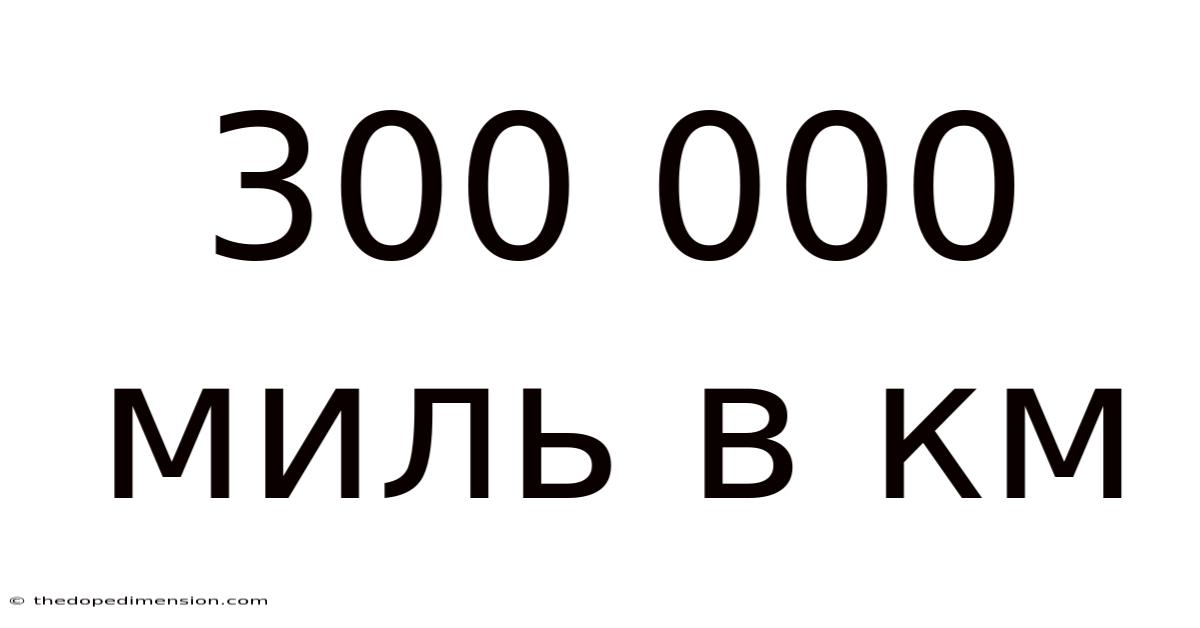300 000 Миль В Км
thedopedimension
Aug 27, 2025 · 4 min read

Table of Contents
300,000 Miles to Kilometers: A Comprehensive Guide to Unit Conversion and its Applications
Converting units is a fundamental skill in many fields, from everyday life to advanced scientific research. Understanding how to convert between different units, such as miles and kilometers, is crucial for accurate calculations and clear communication. This article delves into the conversion of 300,000 miles to kilometers, exploring the process, its applications, and the broader context of unit conversion within the metric and imperial systems. We'll also discuss the importance of accurate conversions and address some common misconceptions.
Understanding Miles and Kilometers
Before we begin the conversion, let's clarify the units involved. Miles are a unit of length in the imperial system, commonly used in the United States and a few other countries. Kilometers, on the other hand, are a unit of length in the metric system, the internationally preferred system of units for its simplicity and consistency.
The fundamental difference lies in the base units. The imperial system is based on various historical standards, leading to a less standardized and often more complex system. The metric system, however, is built upon a decimal system, making conversions between units relatively straightforward. This inherent simplicity is a significant advantage of the metric system.
Converting 300,000 Miles to Kilometers: The Process
The conversion factor between miles and kilometers is approximately 1.60934. This means that one mile is equal to 1.60934 kilometers. To convert 300,000 miles to kilometers, we simply multiply the number of miles by the conversion factor:
300,000 miles * 1.60934 kilometers/mile ≈ 482,802 kilometers
Therefore, 300,000 miles is approximately equal to 482,802 kilometers.
Precision and Significant Figures
It's important to consider the level of precision required when performing unit conversions. The conversion factor (1.60934) itself is an approximation. Depending on the context, you might round the final answer to a certain number of significant figures. For instance, in many practical applications, rounding to the nearest kilometer (482,802 km) would be sufficient. However, in scientific or engineering contexts, more significant figures might be necessary to maintain accuracy.
Applications of Unit Conversion: Real-World Examples
The conversion of units, especially between miles and kilometers, finds applications in various real-world scenarios:
-
Travel and Navigation: GPS systems and maps frequently display distances in both miles and kilometers. Understanding the conversion is essential for accurately interpreting these distances, particularly when traveling internationally.
-
Astronomy and Space Exploration: In astronomy, distances are often measured in astronomical units (AU), light-years, and parsecs. Converting these vast distances to more familiar units like kilometers or miles helps visualize the scale of the universe. For example, the distance to the nearest star, Proxima Centauri, is approximately 4.24 light-years. Converting this distance to kilometers provides a more tangible understanding of its vastness.
-
Aviation and Shipping: In aviation and shipping, accurate distance calculations are critical for navigation and fuel efficiency. Conversions between miles and kilometers are necessary for seamless communication and coordination between different regions using different unit systems.
-
Engineering and Construction: Engineering projects often involve measurements in various units. Accurate unit conversions are essential to avoid errors and ensure compatibility between different components and systems. Consider bridge construction, where precise measurements are paramount for structural integrity. Miscalculations due to incorrect unit conversions can have catastrophic consequences.
-
Geography and Cartography: Maps and geographical data often utilize both miles and kilometers, depending on the region and the target audience. Converting between these units is essential for accurate representation and interpretation of geographical data.
-
Sports and Athletics: Many sports, particularly long-distance running and cycling, involve distances measured in both miles and kilometers. Understanding the conversion is necessary for athletes and coaches to track performance and plan training schedules. A marathon, for instance, is traditionally measured in miles (26.2 miles), while many races globally use kilometers (42.195 km).
Common Misconceptions about Unit Conversion
-
Assuming a simple whole-number conversion: Many mistakenly assume a simple ratio like 1 mile = 1.5 kilometers. This is an oversimplification, leading to significant inaccuracies, especially with larger distances. It's crucial to use the accurate conversion factor (approximately 1.60934) for precise calculations.
-
Ignoring significant figures: Failing to consider significant figures can lead to misleading precision in the final answer. Always round the result appropriately to reflect the accuracy of the input values and the conversion factor.
Advanced Unit Conversion Techniques
While the example of 300,000 miles to kilometers is a straightforward multiplication, more complex conversions often involve multiple steps and the use of conversion factors for multiple units. For example, converting miles per hour to kilometers per second requires converting both distance and time units. This involves multiplying by the distance conversion factor and dividing by the time conversion factor.
Conclusion
Converting 300,000 miles to kilometers, resulting in approximately 482,802 kilometers, demonstrates the importance of understanding and accurately applying unit conversion principles. This seemingly simple calculation has far-reaching implications in various fields, from everyday navigation to advanced scientific research. The accurate conversion of units is not just a mathematical exercise; it's a critical skill that ensures accuracy, clarity, and safety across diverse disciplines. By mastering unit conversion, we can bridge the gap between different systems of measurement and communicate effectively within a globalized world. Understanding the nuances of significant figures and applying accurate conversion factors are key to achieving precise and reliable results.
Latest Posts
Latest Posts
-
Metre Cube To Centimetre Cube
Aug 27, 2025
-
100 Km Hr In Mph
Aug 27, 2025
-
Acre Foot To Cubic Meter
Aug 27, 2025
-
Base Ten To Base Two
Aug 27, 2025
-
Convert 36 Cm To Inches
Aug 27, 2025
Related Post
Thank you for visiting our website which covers about 300 000 Миль В Км . We hope the information provided has been useful to you. Feel free to contact us if you have any questions or need further assistance. See you next time and don't miss to bookmark.